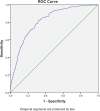Risk factors of nosocomial infection after cardiac surgery in children with congenital heart disease
- PMID: 31964345
- PMCID: PMC6975050
- DOI: 10.1186/s12879-020-4769-6
Risk factors of nosocomial infection after cardiac surgery in children with congenital heart disease
Abstract
Background: The aim of our study was to analyze the risk factors of nosocomial infection after cardiac surgery in children with congenital heart disease (CHD).
Methods: We performed a retrospective cohort study, and children with CHD who underwent open-heart surgeries at Shanghai Children's Medical Center from January 1, 2012 to December 31, 2018 were included. The baseline characteristics of these patients of different ages, including neonates (0-1 months old), infants (1-12 months old) and children (1-10 years old), were analyzed, and the association of risk factors with postoperative nosocomial infection were assessed.
Results: A total of 11,651 subjects were included in the study. The overall nosocomial infection rate was 10.8%. Nosocomial infection rates in neonates, infants, and children with congenital heart disease were 32.9, 15.4, and 5.2%, respectively. Multivariate logistic regression analysis found age (OR 0798, 95%CI: 0.769-0.829; P < 0.001), STS risk grade (OR 1.267, 95%CI: 1.159-1.385; P < 0.001), body mass index (BMI) <5th percentile (OR 1.295, 95%CI: 1.023-1.639; P = 0.032), BMI >95th percentile (OR 0.792, 95%CI: 0.647-0.969; P = 0.023), cardiopulmonary bypass (CPB) time (OR 1.008, 95%CI: 1.003-1.012; P < 0.001) and aortic clamping time (OR 1.009, 1.002-1.015; P = 0.008) were significantly associated with nosocomial infection in CHD infants. After adjusted for confounding factors, we found STS risk grade (OR 1.38, 95%CI: 1.167-1.633; P < 0.001), BMI < 5th percentile (OR 1.934, 95%CI: 1.377-2.715; P < 0.001), CPB time (OR 1.018, 95%CI: 1.015-1.022; P < 0.001), lymphocyte/WBC ratio<cut off value (OR 3.818, 95%CI: 1.529-9.533; P = 0.004) and AST>cut off value (OR 1.546, 95%CI: 1.119-2.136; P = 0.008) were significantly associated with nosocomial infection in CHD children.
Conclusion: Our study suggested STS risk grade, BMI, CPB duration, low lymphocyte/WBC or high neutrophil/WBC ratio were independently associated with nosocomial infection in CHD infant and children after cardiac surgery.
Keywords: Cardiac surgery; Children; Nosocomial infection.
Conflict of interest statement
The authors declare no competing interests.
Figures




Similar articles
-
Risk factors for low cardiac output syndrome in children with congenital heart disease undergoing cardiac surgery: a retrospective cohort study.BMC Pediatr. 2020 Feb 24;20(1):87. doi: 10.1186/s12887-020-1972-y. BMC Pediatr. 2020. PMID: 32093619 Free PMC article.
-
Incidence and risk factors of nosocomial infections after cardiac surgery in Georgian population with congenital heart diseases.Georgian Med News. 2010 Jan;(178):7-11. Georgian Med News. 2010. PMID: 20157198
-
The association between systemic immune-inflammation index (SII) and early nosocomial infections after cardiopulmonary bypass surgery in children with congenital heart disease.BMC Cardiovasc Disord. 2024 Dec 4;24(1):698. doi: 10.1186/s12872-024-04378-w. BMC Cardiovasc Disord. 2024. PMID: 39633275 Free PMC article.
-
Prevalence and Associated Factors of Long-term Growth Failure in Infants with Congenital Heart Disease Who Underwent Cardiac Surgery Before the Age of One.Pediatr Cardiol. 2022 Dec;43(8):1681-1687. doi: 10.1007/s00246-022-02933-w. Epub 2022 Jun 4. Pediatr Cardiol. 2022. PMID: 35661240 Review.
-
Selected 2018 Highlights in Congenital Cardiac Anesthesia.J Cardiothorac Vasc Anesth. 2019 Oct;33(10):2833-2842. doi: 10.1053/j.jvca.2019.03.013. Epub 2019 Mar 8. J Cardiothorac Vasc Anesth. 2019. PMID: 31060934 Review.
Cited by
-
Analysis of the risk factors for severe lung injury after radical surgery for tetralogy of fallot.Front Surg. 2022 Aug 30;9:892562. doi: 10.3389/fsurg.2022.892562. eCollection 2022. Front Surg. 2022. PMID: 36111236 Free PMC article.
-
Impact of Polyhexanide Care Bundle on Surgical Site Infections in Paediatric and Neonatal Cardiac Surgery: A Propensity Score-Matched Retrospective Cohort Study.Int Wound J. 2025 Jun;22(6):e70710. doi: 10.1111/iwj.70710. Int Wound J. 2025. PMID: 40503594 Free PMC article.
-
Digital Online Anaesthesia Patient Informed Consent before Elective Diagnostic Procedures or Surgery: Recent Practice in Children-An Exploratory ESAIC Survey (2021).J Clin Med. 2022 Jan 19;11(3):502. doi: 10.3390/jcm11030502. J Clin Med. 2022. PMID: 35159954 Free PMC article.
-
Hospital Urinary Tract Infections in Healthcare Units on the Example of Mazovian Specialist Hospital Ltd.Front Cell Infect Microbiol. 2022 Jul 11;12:891796. doi: 10.3389/fcimb.2022.891796. eCollection 2022. Front Cell Infect Microbiol. 2022. PMID: 35899043 Free PMC article.
-
Nanobubble Ozone Stored in Hyaluronic Acid-Decorated Liposome Solutions: Inactivating Antibiotic-Resistant Bacteria and Genotoxicity, Sub-Acute and Sub-Chronic Toxicity Tests.Infect Drug Resist. 2025 Jan 16;18:313-328. doi: 10.2147/IDR.S478643. eCollection 2025. Infect Drug Resist. 2025. PMID: 39835164 Free PMC article.
References
MeSH terms
Grants and funding
LinkOut - more resources
Full Text Sources
Medical

